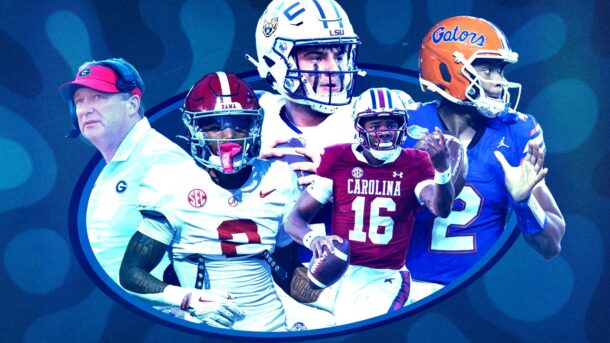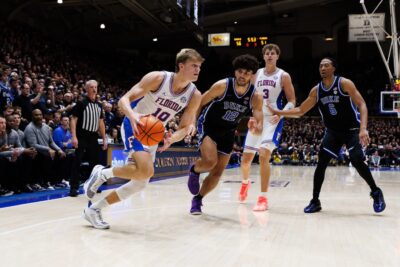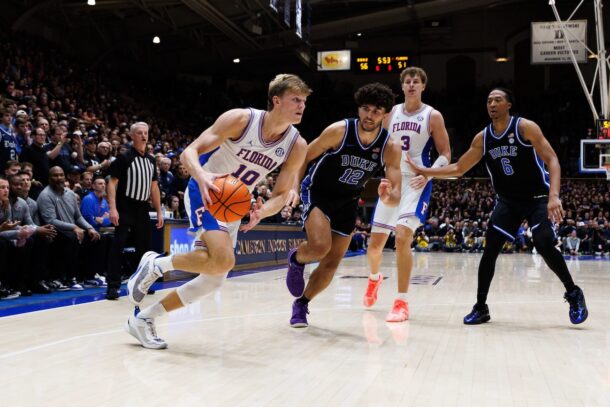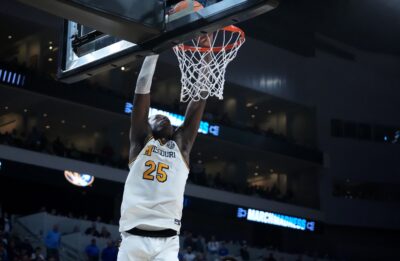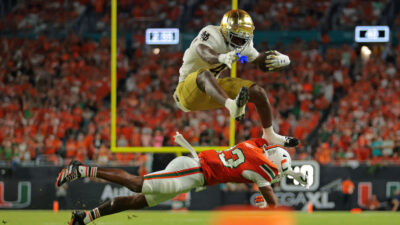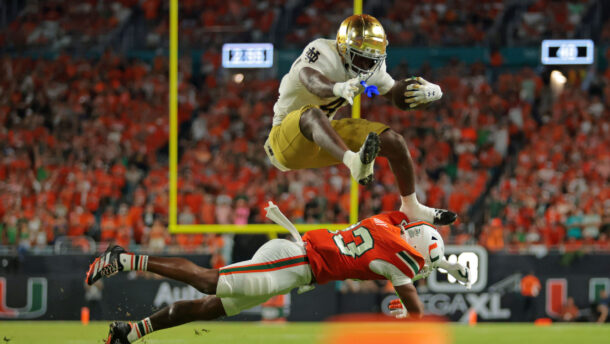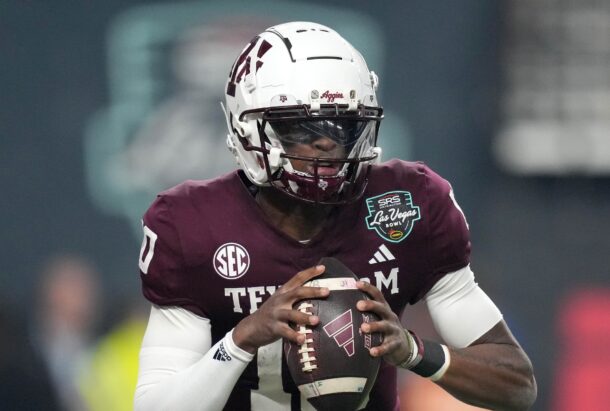
Yes, Texas A&M, here’s why we’re allowed to question Marcel Reed as a passer
I’m a Marcel Reed fan.
That needs to be the disclaimer because the rest of what you’re about to read might suggest that I’m a doubter. I ranked him as my No. 6 quarterback in the SEC coming out of spring, which shouldn’t be scoffed at as we enter a season with all sorts of quarterback depth in the conference. If he ends up leading Texas A&M to late-season Playoff contention again, it won’t surprise me.
But when I saw this tweet from the official A&M account, I had some thoughts:
I don’t have time to dig into the insignificance of quarterbacks throwing passes in shorts without a pass rush in practice, so we’ll save that for another day.
I do, however, have plenty of time to dig into the context of that tweet. “Wait, we thought Marcel Reed wasn’t a passer.”
Ah, here’s the thing. Reed had some pretty clear weaknesses in 2024. They all have to do with him as a passer.
What are those weaknesses, you ask?
Despite that deep ball that Reed threw in shorts without a pass rush in practice, the deep ball was an issue. Reed ranked No. 15 in the SEC with a 27.8% adjusted completion percentage on throws 20 yards downfield (min. 20 such attempts). The only qualified SEC quarterback who was worse was Jackson Arnold. And I included the adjusted completion percentage because it accounts for drops and throwaways … but Reed didn’t have any of those on 20-yard throws.
Sure, one can point out the lack of field-stretchers on A&M’s roster last year and hope that’ll change with transfers KC Concepcion and Mario Craver. That certainly limited the Aggies’ passing attack in 2024. But go look at South Carolina‘s receiver room last year and find the established field-stretchers. You couldn’t, yet LaNorris Sellers still led the SEC with a 56.4% adjusted completion percentage on 20-yard throws.
A weak downfield completion percentage for a first-year starter isn’t necessarily a sign that a guy can’t throw. It is, though, a sign that Reed still has a key area to improve as a passer. That adjusted completion number was better on intermediate throws (60.0%), but that was still No. 11 in the SEC (min. 20 such attempts).
Where else does Reed need to improve? Under pressure.
When he was under pressure, he averaged 4.4 yards per attempt. Among SEC quarterbacks with 50 such dropbacks, only Michael Hawkins Jr. was worse. And if we want to bring adjusted completion percentage back into this, Reed was last among qualified SEC quarterbacks with a 46.2% completion rate under pressure.
If you watched Reed, you saw an issue that plagued him at times. Much like Bo Nix early in his career at Auburn, Reed had a tendency to not properly set his feet or default to his legs when things got tight. On the 96 dropbacks when he was pressured, he scrambled 24 times. That’s 25% of the time. Compare that to fellow mobile SEC quarterbacks like Diego Pavia (15.4%), Taylen Green (14.1%), Jalen Milroe (12.1%), and you’ll see it was a high number. It was slightly above the aforementioned Sellers (24.7%), who might’ve established himself as the best scrambling quarterback in the sport. Reed’s 25% scramble percentage on pressures was actually identical to Arnold, who was also criticized for his pocket presence.
The good news is that unlike Arnold, who had the worst pressure-to-sack percentage in the SEC at 27.3%, Reed only took a sack on 13.5% of the times that he was pressured. The other thing that’s different from Arnold is that Reed will have the benefit of being in Year 2 in his offense with Collin Klein. Quarterback-coordinator continuity is rare in the SEC this year, and it could be at the foundation of a Year 2 step for Reed as a starter.
In Year 1, we saw 3 late-season instances in which Reed had resilient moments when facing a double-digit deficit. Two of those games (South Carolina and Auburn) still ended up being losses, but the one that put him on the map was that LSU comeback. He gave the Aggies a shot of life in what was at the time, their biggest game at Kyle Field of the post-Johnny Manziel era. Reed was responsible for helping A&M overcome that 10-point deficit en route to becoming the last SEC unbeaten in conference play.
Of course, it’s worth noting that as great as Reed was, he fueled that comeback with attempting just 2 passes. He had more rushing touchdowns (3) than passing attempts (2) in what felt like a coming-of-age performance in relief of Conner Weigman. It turned out to the high point of the season, both for Reed and A&M. Defenses seemed better prepared to defend Reed than LSU was that night, and now, he should have a better understanding of how to combat that.
Not having him at SEC Media Days was … a surprise
I say that not to assume it means he’s truly in a quarterback battle with UAB transfer Jacob Zeno, who Mike Elko likes to joke is in Year 11 of college football (it’s Year 7 and he’ll be 25 this fall). But 11 of 16 SEC teams brought quarterbacks to SEC Media Days. That included new starters like John Mateer, Arch Manning, Austin Simmons, Arnold (at Auburn) and Gunner Stockton.
Let me put it this way. If you had told me going in that 5 SEC teams wouldn’t bring a quarterback to Media Days, I wouldn’t have picked A&M to be part of that group.
Elko can say he wanted to give that honor to upperclassmen or multi-year starters, but A&M’s ceiling comes down to Reed. For a program that’s had 4 consecutive seasons of multiple starting quarterbacks in the post-Kellen Mond era, A&M fans don’t need any reminders of how important stability at that position is. That 2020 season, wherein A&M earned its highest ranking in the final AP Poll (No. 4) since 1939, was the last time that the Aggies finished as a ranked team. They benefitted from stability at quarterback, as well as a healthy offensive line and an Elko-coached defense.
This 2025 A&M squad could benefit from having all those factors in play. Reed has to hold up physically, and he has to hold up the QB1 title for a defensive-minded coach who made 2 in-season quarterback changes in Year 1. In order to do that, Reed has to improve as a passer. It’s as simple as that.
It’s not about the lack of 300-yard passing performances, or whether he completes 70% of his passes. It’s about showing that Reed can win games in multiple ways, and making A&M a brutal offense to prepare for. If he can do that, Reed and the Aggies will get the last laugh.
Until then, though, we can chuckle when A&M fires off a tweet that pretends legitimate concerns about his game are just lazy media narratives.
Connor O'Gara is the senior national columnist for Saturday Down South. He's a member of the Football Writers Association of America. After spending his entire life living in B1G country, he moved to the South in 2015.
